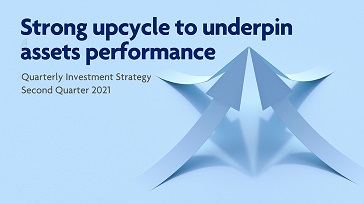Key Highlights
- Wall Street indices extended winning streak as latest earnings beat estimates
- Latest US jobs and retail data point to quickened pace of economic recovery
- Investors will keep eyes on PPI and CPI for signs of inflationary pressure
US stocks closed another week (12-16 April) on new highs with all three major indices up by more than 1% – the S&P 500 hit a new high of 4,185 while the Dow Jones Industrials Average also reached a new milestone at 34,200 or a gain of 400 points, both extending their winning streak to a fourth week while Nasdaq Composite closed Friday at 14,052, advancing for the third week in a row.
Investor sentiments were buoyed by market anticipation of quickening growth prospects that were prompted by the latest earnings report which beat estimates by a wide margin of more than 84%. According to FactSet, profit growth for the S&P 500 is up 30.2% for the quarter so far, making it the best three-month period since the third quarter of 2010.
The mood of the market was also lifted by a spate of positive economic data – from a dip in jobless claims to strong rebounds in both consumer sentiments and spending with US retail sales chalking up nearly 10% increase for March, while the University of Michigan preliminary consumer sentiment index rose to a one-year high of 86.5 in the first half of April from 84.9 in March.
All these pointed to expectations of further improvement in US economic activity in the coming months in the wake of the recent fiscal stimulus and an improving public health landscape as US vaccination numbers continue to rise with more than half of Americans getting the vaccine jab.
That has helped to lift both growth and cyclical or value stocks on optimism that corporate earnings will race ahead of expectations on the back of pent-up demand from consumers, especially after one of the US Federal Reserve governors noted that there is no reason to tighten Fed policies even when “the economy is ready to rip” with the virus under control.
Under such a scenario, there are those who think that some outperforming value stocks may even become momentum stocks with the value-momentum convergence lasting longer than previous spells in the past.
The 10-year bond yields closed at 1.59% on Friday and may likely hover in the 1.50% to 1.75% range depending on where the market’s view of inflation – whether it is “transitory” as Fed policymakers have asserted repeatedly; or if it will climb and squeeze corporate margins, particularly industrials, materials and consumer companies with oil prices up by 30% since the start of the year and copper futures up by about 17%.
That said, some of the pick-up in US inflation can also be attributed to very low levels last year during pandemic lockdowns. Some market watchers have even viewed the imperviousness of US treasuries to ever stronger data as a Goldilocks’ situation where the inflation outcome is already priced to perfection amid positive growth.
Investors will be looking closely in the weeks ahead at both the producer price (PPI) and consumer price (CPI) indexes as well as details in the proposed corporate tax hikes by the Biden administration from 21% to 28% to pay for the next stimulus – a $2 trillion infrastructure plan.
Despite the upbeat mood in the market, Fed chair Jerome Powell had repeated that the threat of the virus spiking again due to new strains that are more infectious and harder to treat remains a risk to the pace of growth.
There were setbacks during the week as the US put on hold the use of the Johnson & Johnson vaccine, mirroring the action of some European counterparts for the AstraZeneca drug – both on concerns over possible blood clots in some vaccine recipients, though an infinitesimal number compared to the more than 875 million doses dispensed worldwide.
Meanwhile, infections have continued to surge in Brazil and India while other countries that had previously avoided widespread transmission are now seeing steep increases in infections, according to the World Health Organisation (WHO) pushing global infections toward their highest level in the pandemic – with the number of new cases per week nearly doubled over the past two months.
Geopolitical risks may have also crept up a notch in light of new US sanctions on Russia for interfering in the 2020 elections as well as a warning to Beijing by US Secretary of State Antony Blinken after Chinese war planes reportedly incurred Taiwan’s air space on several occasions during the past weeks. That said, the US and China have also jointly announced over the weekend they will commit to cooperate with each other and other countries to tackle climate change with urgency.
This publication shall not be copied or disseminated, or relied upon by any person for whatever purpose. The information herein is given on a general basis without obligation and is strictly for information only. This publication is not an offer, solicitation, recommendation or advice to buy or sell any investment product, including any collective investment schemes or shares of companies mentioned within. Although every reasonable care has been taken to ensure the accuracy and objectivity of the information contained in this publication, UOB Asset Management Ltd ("UOBAM") and its employees shall not be held liable for any error, inaccuracy and/or omission, howsoever caused, or for any decision or action taken based on views expressed or information in this publication. The information contained in this publication, including any data, projections and underlying assumptions are based upon certain assumptions, management forecasts and analysis of information available and reflects prevailing conditions and our views as of the date of this publication, all of which are subject to change at any time without notice. Please note that the graphs, charts, formulae or other devices set out or referred to in this document cannot, in and of itself, be used to determine and will not assist any person in deciding which investment product to buy or sell, or when to buy or sell an investment product. UOBAM does not warrant the accuracy, adequacy, timeliness or completeness of the information herein for any particular purpose, and expressly disclaims liability for any error, inaccuracy or omission. Any opinion, projection and other forward-looking statement regarding future events or performance of, including but not limited to, countries, markets or companies is not necessarily indicative of, and may differ from actual events or results. Nothing in this publication constitutes accounting, legal, regulatory, tax or other advice. The information herein has no regard to the specific objectives, financial situation and particular needs of any specific person. You may wish to seek advice from a professional or an independent financial adviser about the issues discussed herein or before investing in any investment or insurance product. Should you choose not to seek such advice, you should consider carefully whether the investment or insurance product in question is suitable for you.





